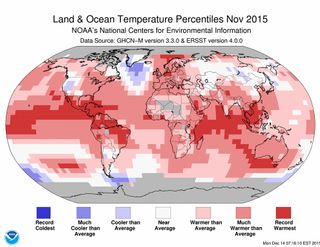November Burns Through Temperature Records

This November was the warmest on record, according to a monthly climate update issued by the National Oceanic and Atmospheric Association (NOAA) National Centers for Environmental Information. November was also the seventh month in a row to average global temperatures that were not only warmer than average, but also broke records set during previous years.
NOAA scientists based their report on global temperature data going back to 1880, when climate record-keeping began.
To determine global temperatures, scientists average surface temperatures on land and in the oceans. November's data showed that across the globe, average land-surface temperature was higher than the 20th century average by 2.36 degrees Fahrenheit (1.31 degrees Celsius). This year's average sea-surface temperature was higher than the 20th century average by 1.51 degrees F (0.84 degrees C), also a record-breaking number. [In Images: Extreme Weather Around the World]
Over land and sea surface combined, the November average temperature was 1.75 degrees F (0.97 degrees C) higher than the 20th century average.
From September through November in the contiguous United States this year, temperatures in every single state were warmer than average, with record warmth recorded in Florida. The entire year of 2015 will likely prove to be one of the five warmest ever recorded in the United States, with record and near-record warmth in Florida, Nevada, Washington and Oregon.
When weather and climate agencies like NOAA incorporate monthly reports like these into the larger record of climate data, they can compare average temperatures over time to detect patterns of how Earth's climate is changing, and how quickly.
In the last 100 years, temperatures on Earth — averaged over land and sea surface —warmed by about 1.53 degrees F (0.85 degrees C), according to a 2013 assessment from the Intergovernmental Panel on Climate Change (IPCC). In 2009, the United Nations Framework Convention on Climate Change proposed a goal to global leaders — keep average temperature rise to under 2 degrees C (3.6 degrees F.) And with warming already estimated at 0.85 degrees C, the world is nearly halfway there.
Sign up for the Live Science daily newsletter now
Get the world’s most fascinating discoveries delivered straight to your inbox.
On Dec. 12, 195 countries and the European Union agreed to adopt a landmark global climate plan intended to combat climate change, following the 21st Conference of the Parties (COP 21) to the United Nations Framework Convention on Climate Change (UNFCCC) in Paris. World leaders affirmed their commitment to action with the Paris Agreement, pledging to take steps to restrict average temperature rise to below the 2-degree C limit proposed in 2009.
The agreement, which will be kept at the United Nations Headquarters in New York City, lays important groundwork for the international collaborations that will be necessary to slow the pace of global warming and address the factors that are driving it, the UNFCC said.
Follow Mindy Weisberger on Twitter and Google+. Follow us @livescience, Facebook & Google+. Original article on Live Science.

Mindy Weisberger is an editor at Scholastic and a former Live Science channel editor and senior writer. She has reported on general science, covering climate change, paleontology, biology and space. Mindy studied film at Columbia University; prior to Live Science she produced, wrote and directed media for the American Museum of Natural History in New York City. Her videos about dinosaurs, astrophysics, biodiversity and evolution appear in museums and science centers worldwide, earning awards such as the CINE Golden Eagle and the Communicator Award of Excellence. Her writing has also appeared in Scientific American, The Washington Post and How It Works Magazine. Her book "Rise of the Zombie Bugs: The Surprising Science of Parasitic Mind Control" will be published in spring 2025 by Johns Hopkins University Press.
Most Popular


